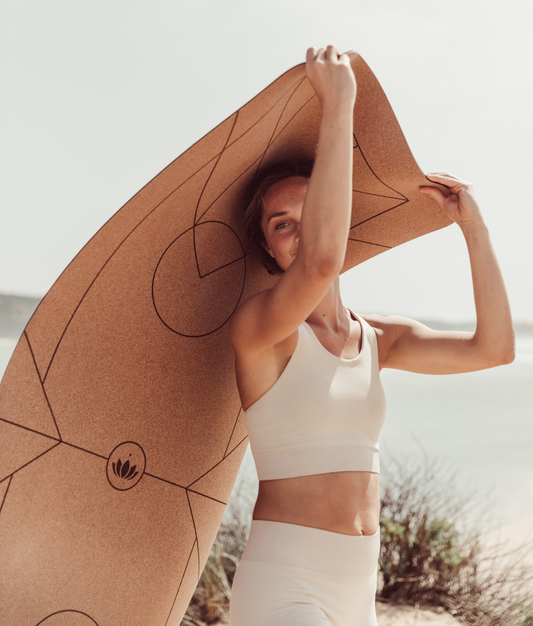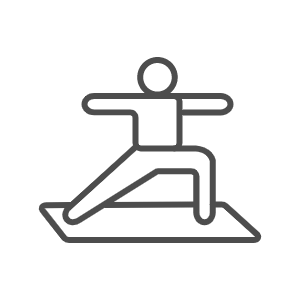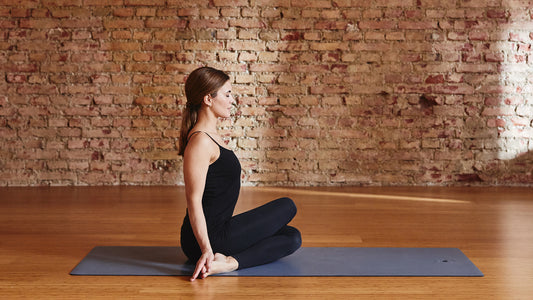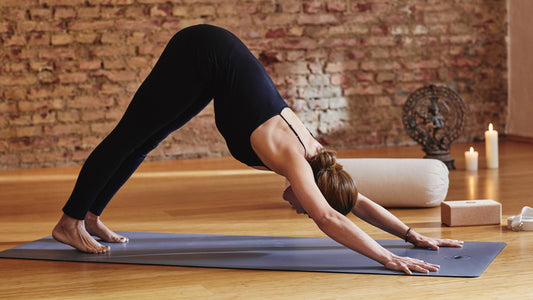
NEW In!
PURE-Matte Light TaupeShopping cart
Your shopping basket is empty
Yoga

Meditation
Sets & Bundles
Downward dog, cobra, warrior - even if you haven't delved into yoga before, you probably know these asana names. But with all the different yoga styles that exist, you naturally have the choice between countless other exercises. Whether you are a beginner or an advanced practitioner , whether you want to lose weight or relax , whether you want to do yoga alone or with a partner : we have collected the best exercises for you!
In yoga tutorials or courses, the Sanskrit terms are often used, so that as a newcomer you can lose track. Actually, all you have to know is that a physical exercise is called an asana and that yoga poses always end with "-asana". For example, Downward-Facing Dog is Adho Mukha Shvanasana.
You don't necessarily have to go to a studio for a yoga session, because with comfortable clothing and a soft, non-slip surface, you're ready to start in your own four walls. If you are just starting your yoga journey, you are well advised to try classic hatha and yin yoga asanas.
Hatha style focuses on physical exercise and breathing, while Yin Yoga focuses on relaxation. When trying it out, just pay attention to what suits you the most and don't force yourself into anything.
Back exercises can be beneficial if you suffer from frequent lower back pain, for example.
You are on all fours and let your abdomen and spine sag as you inhale. As you exhale, make a cat hump. This asana is good for warming up.
Just make sure your knees are under your hip joints and your fingers are stretched straight out in front.

You lie on your back and place the soles of your feet on the mat. Reach your fingers toward your heels, then lift your pelvis up, creating an oblique line from your knees to your head. Hold this position for several breaths.
You will find that just breathing calmly can have a significantly positive effect on your balance. For example, with concentration you master the tree (Vrksasana):
For example, from a standing position, slowly bend your right leg outwards and then grab your ankle with your right hand. In a controlled manner, you guide your foot to the inside of your left thigh and place it there. You can then join your hands in the Namasté greeting or stretch them out to the side.
Many yoga units contain elements where you can stretch well. In this way, the strength exercises are balanced again.
You lie on your stomach with your forearms flat on the mat. Make sure your elbows are under your shoulders. Now straighten your spine upwards, creating a gentle curve in your back.
But be careful: you shouldn't hollow your back.
The shoulders also tend to slouch forward in these asanas - make sure to consciously pull them back.

You can transition seamlessly from the cobra to the arch by grasping your ankles with your hands while lying on your stomach so that your whole body takes on a rounded shape. If it's comfortable, you can gently rock back and forth, otherwise just hold the pose for a few breaths.
No Yogi is perfect, and that's why you can use tools at any time. The yoga block is particularly practical because it helps, for example, to maintain balance and creates a connection to the floor like an extension of the arms . This allows you to hold difficult positions for several breaths. If you, as a beginner, still find the cross-legged position uncomfortable because your hips are not wide open , you can also sit on the block.
You stand in a straddle position on the mat with your arms stretched out to the side. Your right foot is parallel to the back end of the mat while you rotate your left foot 90 degrees so it is parallel to the long side. Make sure you have a firm footing - your whole foot should be in contact with the mat.
As you exhale, bring your left arm down towards the floor while your right arm is pointing straight up. In this pose you can support yourself well on the block. Make sure your back is straight and your pelvis is frontal, so you don't bend sideways.
Balance is also required for this asana and the yoga block will help you to hold it. You start again in the straddle and on the exhale lift your right leg parallel to the floor while you bend your upper body to the left.
There should be a straight line from your head to your right foot.
You can support your left arm on the block again, the right arm points vertically upwards. Again, you should not buckle with the pelvis. Take your time and find your way into a properly executed asana.

You lie on your back, bend your knees and place your feet on the floor. The fingertips reach back to the heels. Now lift your pelvis and place the block under your sacrum so that you can support yourself on it.
You can use this exercise to prepare for shoulderstand, for example. Again you start lying on your back, but this time stretch your legs straight up and lift your pelvis in a controlled manner. The block is placed horizontally under the sacrum so your weight can rest on it. The arms lie flat and straight next to the torso.
You should always hold all exercises for at least 4-5 breaths . Consciously pay attention to every part of your body: Is your back crooked, your neck too tense? Are your feet directly under your hips and your shoulders relaxed?
You can do yoga not only alone, but also together with another person . By the way, couple yoga doesn’t have to mean couple yoga – your partner can just as well be a family member, for example! The aim of the joint exercises is to build trust and compassion, but also a feeling for yourself and to release inner blockages. In practice this works as follows:
Since yoga also uses deep muscle groups , you can lose weight and define your body with regular sessions. This works best with slightly advanced poses.
Sweat flows during Power Yoga because individual muscles are clearly stressed. That makes you strong and flexible . The longer you can hold the asanas and the more often you repeat them, the greater the effect - but you shouldn't turn it into a competitive sport.
You stand straddle, your back foot is parallel to the end of the mat and your front foot is parallel to the long side of the mat. Now bend your front knee and, with your arms stretched out, bend your upper body in the direction that the bent knee is pointing. Stay straight and maintain body tension, especially in the abdomen.
With your legs apart, squat on your heels and place your palms on the floor in front of you. Shift your weight forward so your knees are on your elbows and your feet are off the floor. Attention: This exercise requires a lot of balance and body tension!

The pose's name is self-explanatory: this is where your body weight rests on your head, so it's especially important to tense your neck. For example, you can get into the headstand over the crow by taking your knees off your elbows and slowly stretching them vertically upwards. In this case, too, nothing works without body tension.
Here the focus is particularly on linking the movements with breathing . In fact, most types of yoga contain certain flow elements, i.e. smooth transitions between asanas. Among other things, Power Yoga partly follows the Vinyasa style. A classic Vinyasa flow is the sun salutation (Surya Namaskar). It consists of several asanas:
You can combine these and all other yoga styles and asanas as you like. To be on the safe side, you should only try more complicated asanas when you can optimally assess your strength, balance and body tension . Ultimately, it's not about twisting yourself as much as possible and looking elegant while doing yoga. Only if you adapt the exercises exactly to your pace and your needs can yoga unfold its countless positive effects.

Alongside various styles of yoga, meditation has been a common relaxation practice in our society for some time. Many people swear by the so-called...
Continue reading
Yoga is an ancient practice that has been really booming here for a number of years. No wonder, since many people have now discovered that in an in...
Continue reading